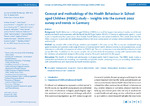Concept and methodology of the Health Behaviour in Schoolaged Children (HBSC) study – Insights into the current 2022 survey and trends in Germany
Winter, Kristina
Moor, Irene
Markert, Jenny
Bilz, Ludwig
Bucksch, Jens
Dadaczynski, Kevin
Fischer, Saskia M.
Helmchen, Ronja M.
Kaman, Anne
Möckel, Juliane
Rathmann, Katharina
Ravens-Sieberer, Ulrike
Reiß, Franziska
Schierl, Theresa
Schütz, Raphael
Sendatzki, Saskia
Stürmer, Elisabeth
Sudeck, Gordon
Richter, Matthias
Background: Health Behaviour in School-aged Children (HBSC) is one of the largest international studies on child and adolescent health and cooperates with the World Health Organization (WHO). In Germany, adolescents aged 11, 13 and 15 are surveyed every four years about their health, health behaviour and social conditions. This article describes the HBSC study and in particular the methodology of the current 2022 survey and prior surveys conducted between 2009/10 and 2017/18.
Method: 174 schools with a total of 6,475 students participated in the 2022 survey. The survey was conducted using questionnaires and covered a wide range of topics (including mental health, physical activity, bullying experiences, social determinants of health and experiences related to COVID-19). The 2022 survey was complemented by a school principal survey (N = 160). In addition to the current sample, the samples of the three previous surveys with representative data for Germany are presented: 2009/10 (N = 5,005), 2013/14 (N = 5,961) and 2017/18 (N = 4,347).
Discussion: The health of children and adolescents is of great public health importance. The HBSC study makes a substantial contribution by providing internationally comparable results, analysing trends, and providing stakeholders with comprehensive and representative health monitoring data.
Dateien zu dieser Publikation

